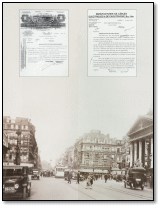They wrote the history of electricity
None of the industrial and domestic applications which ensure our efficiency at
work and well-being in the home would exist without the genius of researchers
who, over the past two hundred years, have constantly broken new ground in the
exploitation of energy. Let us remember some of these major figures in the
history of electricity :
1820
- Christian Oersted, a Danish physicist, discovered the existence of the
magnetic field created by electric currents.
1825
- Sturgeon (Great Britain) invented the electromagnet.
1833
- Michael Faraday, an English physicist, developed the theory of
electrostatic influence, defined the laws of electrolysis and discovered
electromagnetic induction.

1837
- Samuel Morse, a US physicist, invented the electric telegraph and its
alphabet.
1859
- Gaston Planté, a French physicist, built the first electric
battery.
1866
- Werner von Siemens (Germany), author of a remarkable series of studies
on electricity used for the production of power, developed the electric dynamo
based on the research of Wheatstone and Varley (Great Britain).
1868
- Zénobe Gramme, a Belgian electrician, invented the first
industrial dynamo permitting the production of an electric current.
1873
- Aristide Bergès, a French engineer, first generated
hydroelectric power.
1877
- Invention of electric welding.
1878
- Thomas Edison, the US physicist, invented a number of electrical
devices, including the light bulb.
1879
- Siemens (Germany) built, for the Berlin Exhibition, the first electric
locomotive pulling a train of wagons for passenger transport.
1881
- Siemens (Germany) built the first electric tramway line in Berlin.
1883
- Lucien Goulard (France) and Dixon Gibbs (England), both engineers,
developed what is considered to be the forerunner of the
"transformer".
1885
- The Ganz Company patented the "electric transformer",
following joint research by the Hungarian engineers Zipernowski-Deri and Blathy.
1887
- Heinrich Hertz, a German physicist, discovered electric or Hertzian
waves, together with the photo-electric effect.
1889
- von Delivo Dobroewiski (Germany) developed and patented the
"triphase transformer".
1890
- Marey (France) developed a device able to take up to 16 photos a second.
1892
- Edison created his kinetoscope able to show a succession of images
creating the impression of movement.
1893
- Elster and Geitel (Germany) developed the photoelectric cell.
1895
- The Lumière brothers (France) presented their device for film
projection.
|
1898
- First electric power station opened in Oisquerecq with a power of more
than 100 kW. (The present installed power in Belgium is 15,339,00 kW).
|
|
CEBEC. 1923-1998
75 years in the service of the quality of life
75 years of professional activity to ensure safe and efficient human activity
with the comfort of electricity in the home, at work and during leisure
activities.
This reality is the result of 75 years of constant efforts to study every
product and device and to define standards ensuring safety of use and quality
of components. 75 years devoted to controlling tens of thousands of products
and awarding the CEBEC quality mark.
Homage to our predecessors
Back at the very beginning of the century, our predecessors pooled their
professionalism to ensure the efficient and problem-free comfort of
electricity. They formed companies, drew up safety and quality standards, and
created the bodies to ensure their application.
The Belgian Electrotechnical Committee
Founded in 1884, the Belgian Society of Electricians (SBE) already had 230
members in 1885 and experienced growing success. It defined its mission in 1906
and in 1909 founded the Belgian Electrotechnical Committee (CEB), charged with
the following tasks :
-
To define safety and quality standards for electrotechnical equipment
-
To ensure compliance of equipment with its standards by means of detailed
examinations and testing by an approved laboratory.
-
To award quality marks to equipment manufactured according to its
recommendations.
... Some famous names...
PLATEAU Joseph (1801-1883).
Physicist. Developed the phenomenon of retinal retention and invented (1832)
the phenakistoscope, a device which was the direct forerunner of the cinema.
MELSENS Louis (1814-1886).
Physicist and chemist. Perfected the lightning rod by applying the principle
of the Faraday cage. First president of the Belgian Electrotechnical Committee.
LENOIR Etienne (1822-1900).
Belgian born, naturalised French engineer. Produced and operated the first
internal combustion engine by air expansion following the combustion of ignited
gases which permitted the production of a four-stroke engine.
GRAMME Zénobe (1826-1901).
Self-taught physicist. Won worldwide acclaim as inventor of the dynamo.
MONTEFIORE-LEVI (1832-1906).
Engineer. Senator for Liège from 1882 to 1901. Founder of the Belgian
Montefiore Institute which trains civil electrical engineers.
VAN MONCKHOVEN Désiré (1834-1882).
Chemist. Manufactured photographic plates which met with great success.
SOLVAY Ernest (1882-1922).
Chemist and industrialist. His discovery of caustic soda was industrially
exploited by the Société Solvay et Cie which became one of the
worldwide giants of the chemical industry.
FIEVEZ Charles (1844-1890).
Engineer. One of the 19th century's great astronomers. Studied the solar
spectrum.
BRANLY Edouard (1844-1940).
Inventor of one of the first cableless telegraph systems. Elected honorary
member of the Belgian Society of Electricians in 1932.
|
|


